Capella University BUS-FP4014: Inventory and Ordering Decisions
VerifiedAdded on 2022/08/27
|11
|2323
|22
Homework Assignment
AI Summary
This assignment addresses operations management challenges faced by ABC Manufacturing, including competitive pricing, supply chain issues, and product reliability. The solution focuses on internal improvements such as lean manufacturing implementation to improve product reliability, human resource planning, and competitive pricing strategies based on demand analysis and market research. The assignment includes calculations for aggregate production rate, employee requirements, economic order quantity (EOQ), reorder point, and an overview of various forecasting methods (Naïve, Simple Mean, Simple Moving Average, Weighted Moving Average, Exponential Smoothing, and Linear Trend Line) to optimize inventory and production processes. The goal is to achieve operational efficiency, improve product quality, enhance customer satisfaction, and gain a competitive advantage.
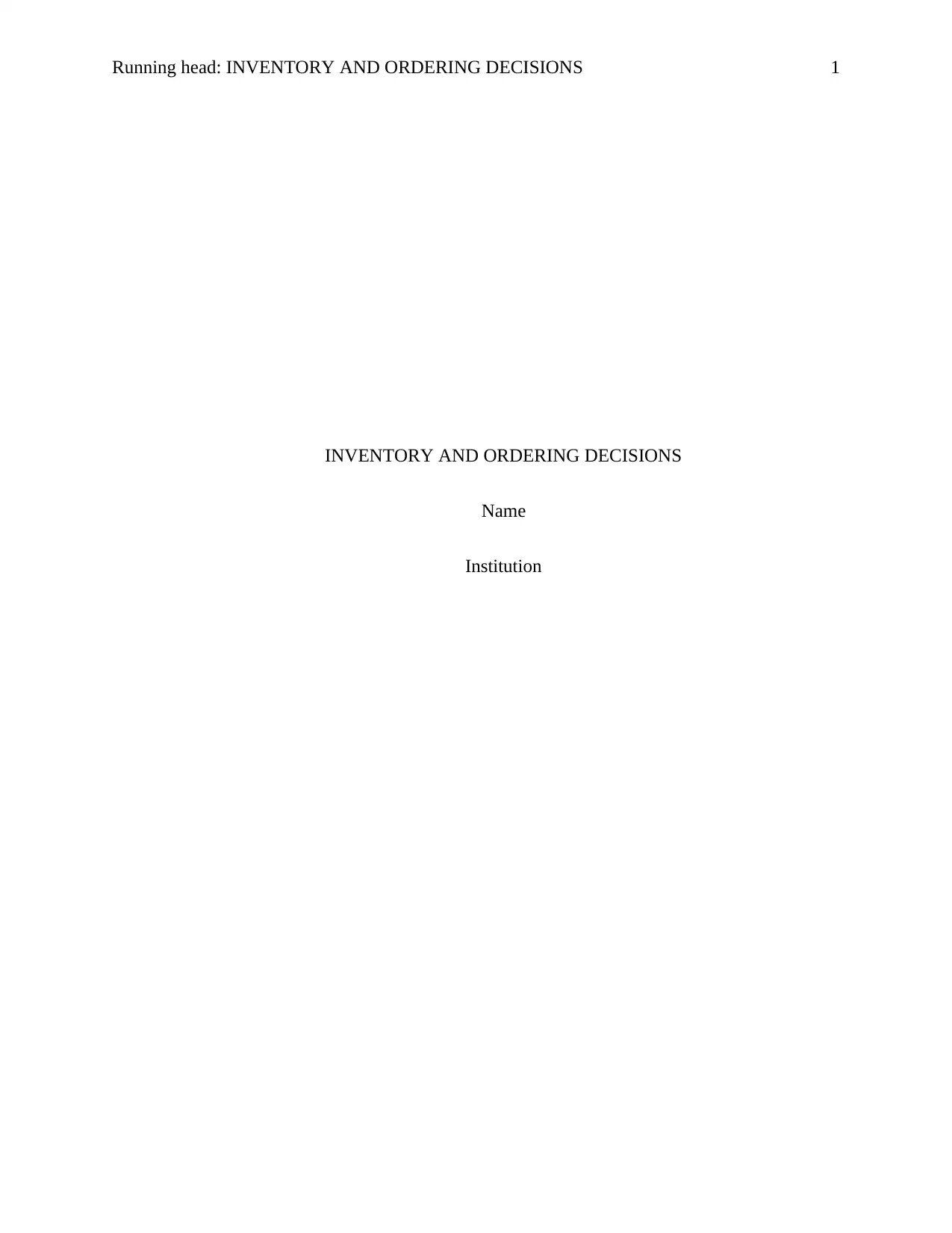
Running head: INVENTORY AND ORDERING DECISIONS 1
INVENTORY AND ORDERING DECISIONS
Name
Institution
INVENTORY AND ORDERING DECISIONS
Name
Institution
Paraphrase This Document
Need a fresh take? Get an instant paraphrase of this document with our AI Paraphraser
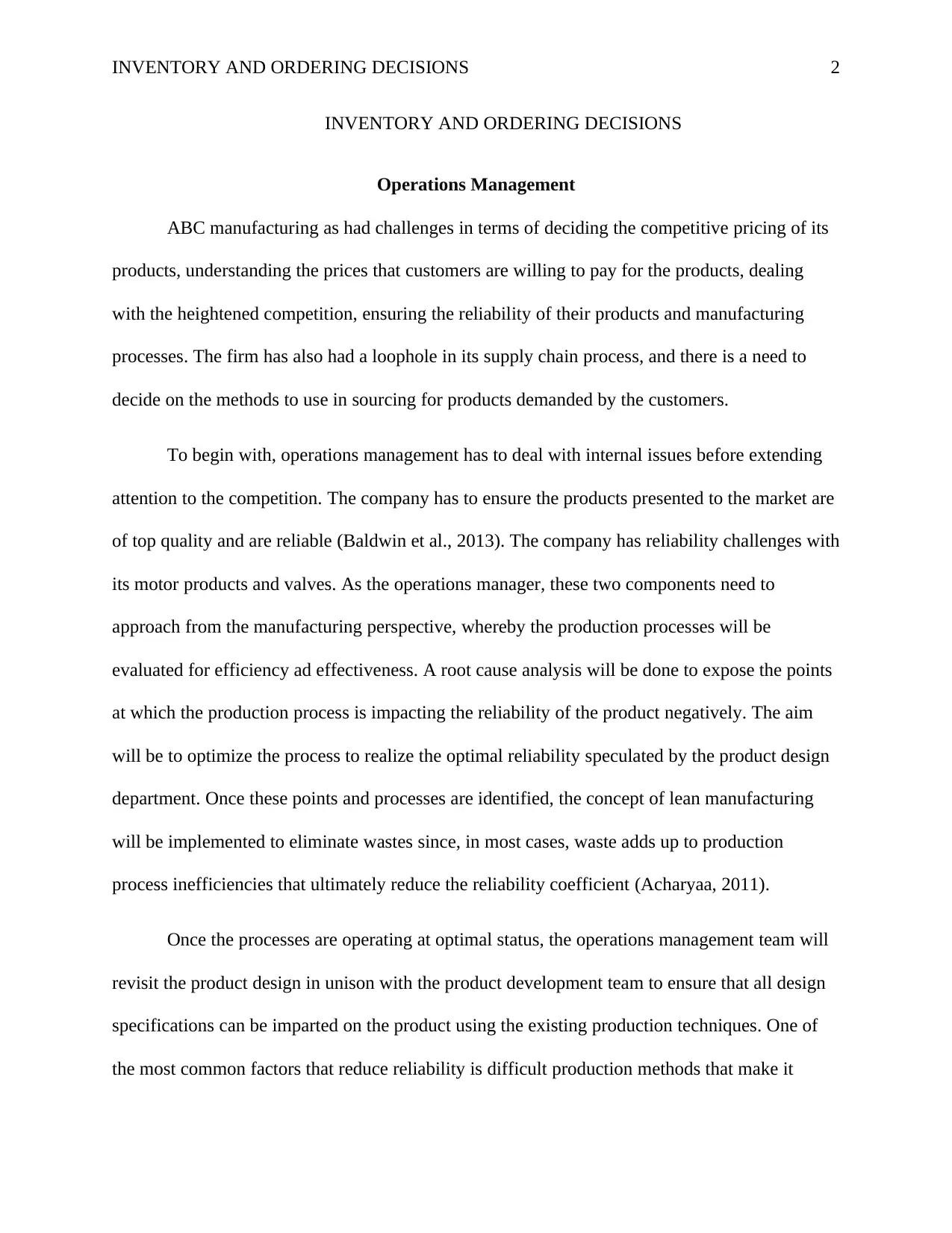
INVENTORY AND ORDERING DECISIONS 2
INVENTORY AND ORDERING DECISIONS
Operations Management
ABC manufacturing as had challenges in terms of deciding the competitive pricing of its
products, understanding the prices that customers are willing to pay for the products, dealing
with the heightened competition, ensuring the reliability of their products and manufacturing
processes. The firm has also had a loophole in its supply chain process, and there is a need to
decide on the methods to use in sourcing for products demanded by the customers.
To begin with, operations management has to deal with internal issues before extending
attention to the competition. The company has to ensure the products presented to the market are
of top quality and are reliable (Baldwin et al., 2013). The company has reliability challenges with
its motor products and valves. As the operations manager, these two components need to
approach from the manufacturing perspective, whereby the production processes will be
evaluated for efficiency ad effectiveness. A root cause analysis will be done to expose the points
at which the production process is impacting the reliability of the product negatively. The aim
will be to optimize the process to realize the optimal reliability speculated by the product design
department. Once these points and processes are identified, the concept of lean manufacturing
will be implemented to eliminate wastes since, in most cases, waste adds up to production
process inefficiencies that ultimately reduce the reliability coefficient (Acharyaa, 2011).
Once the processes are operating at optimal status, the operations management team will
revisit the product design in unison with the product development team to ensure that all design
specifications can be imparted on the product using the existing production techniques. One of
the most common factors that reduce reliability is difficult production methods that make it
INVENTORY AND ORDERING DECISIONS
Operations Management
ABC manufacturing as had challenges in terms of deciding the competitive pricing of its
products, understanding the prices that customers are willing to pay for the products, dealing
with the heightened competition, ensuring the reliability of their products and manufacturing
processes. The firm has also had a loophole in its supply chain process, and there is a need to
decide on the methods to use in sourcing for products demanded by the customers.
To begin with, operations management has to deal with internal issues before extending
attention to the competition. The company has to ensure the products presented to the market are
of top quality and are reliable (Baldwin et al., 2013). The company has reliability challenges with
its motor products and valves. As the operations manager, these two components need to
approach from the manufacturing perspective, whereby the production processes will be
evaluated for efficiency ad effectiveness. A root cause analysis will be done to expose the points
at which the production process is impacting the reliability of the product negatively. The aim
will be to optimize the process to realize the optimal reliability speculated by the product design
department. Once these points and processes are identified, the concept of lean manufacturing
will be implemented to eliminate wastes since, in most cases, waste adds up to production
process inefficiencies that ultimately reduce the reliability coefficient (Acharyaa, 2011).
Once the processes are operating at optimal status, the operations management team will
revisit the product design in unison with the product development team to ensure that all design
specifications can be imparted on the product using the existing production techniques. One of
the most common factors that reduce reliability is difficult production methods that make it
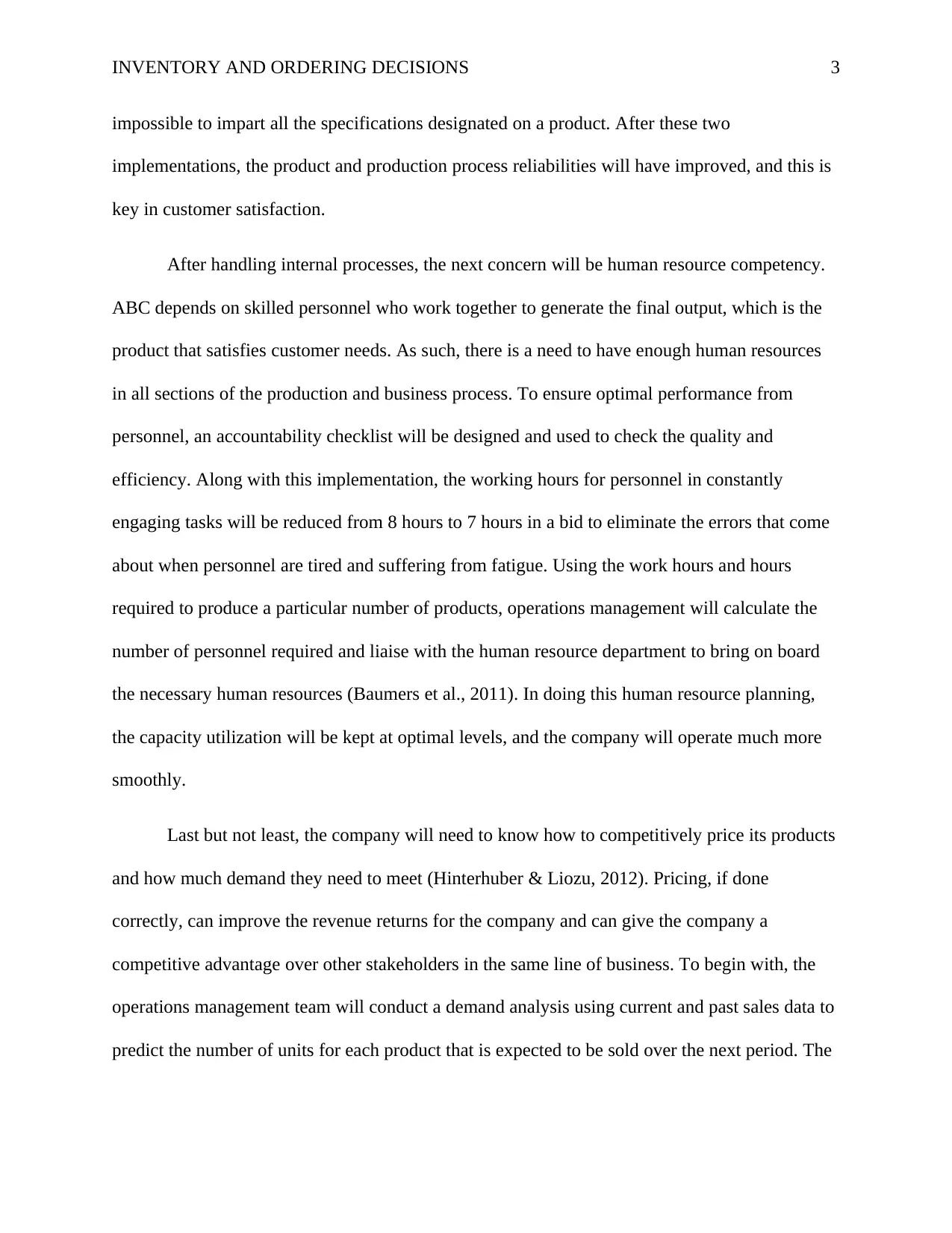
INVENTORY AND ORDERING DECISIONS 3
impossible to impart all the specifications designated on a product. After these two
implementations, the product and production process reliabilities will have improved, and this is
key in customer satisfaction.
After handling internal processes, the next concern will be human resource competency.
ABC depends on skilled personnel who work together to generate the final output, which is the
product that satisfies customer needs. As such, there is a need to have enough human resources
in all sections of the production and business process. To ensure optimal performance from
personnel, an accountability checklist will be designed and used to check the quality and
efficiency. Along with this implementation, the working hours for personnel in constantly
engaging tasks will be reduced from 8 hours to 7 hours in a bid to eliminate the errors that come
about when personnel are tired and suffering from fatigue. Using the work hours and hours
required to produce a particular number of products, operations management will calculate the
number of personnel required and liaise with the human resource department to bring on board
the necessary human resources (Baumers et al., 2011). In doing this human resource planning,
the capacity utilization will be kept at optimal levels, and the company will operate much more
smoothly.
Last but not least, the company will need to know how to competitively price its products
and how much demand they need to meet (Hinterhuber & Liozu, 2012). Pricing, if done
correctly, can improve the revenue returns for the company and can give the company a
competitive advantage over other stakeholders in the same line of business. To begin with, the
operations management team will conduct a demand analysis using current and past sales data to
predict the number of units for each product that is expected to be sold over the next period. The
impossible to impart all the specifications designated on a product. After these two
implementations, the product and production process reliabilities will have improved, and this is
key in customer satisfaction.
After handling internal processes, the next concern will be human resource competency.
ABC depends on skilled personnel who work together to generate the final output, which is the
product that satisfies customer needs. As such, there is a need to have enough human resources
in all sections of the production and business process. To ensure optimal performance from
personnel, an accountability checklist will be designed and used to check the quality and
efficiency. Along with this implementation, the working hours for personnel in constantly
engaging tasks will be reduced from 8 hours to 7 hours in a bid to eliminate the errors that come
about when personnel are tired and suffering from fatigue. Using the work hours and hours
required to produce a particular number of products, operations management will calculate the
number of personnel required and liaise with the human resource department to bring on board
the necessary human resources (Baumers et al., 2011). In doing this human resource planning,
the capacity utilization will be kept at optimal levels, and the company will operate much more
smoothly.
Last but not least, the company will need to know how to competitively price its products
and how much demand they need to meet (Hinterhuber & Liozu, 2012). Pricing, if done
correctly, can improve the revenue returns for the company and can give the company a
competitive advantage over other stakeholders in the same line of business. To begin with, the
operations management team will conduct a demand analysis using current and past sales data to
predict the number of units for each product that is expected to be sold over the next period. The
⊘ This is a preview!⊘
Do you want full access?
Subscribe today to unlock all pages.

Trusted by 1+ million students worldwide
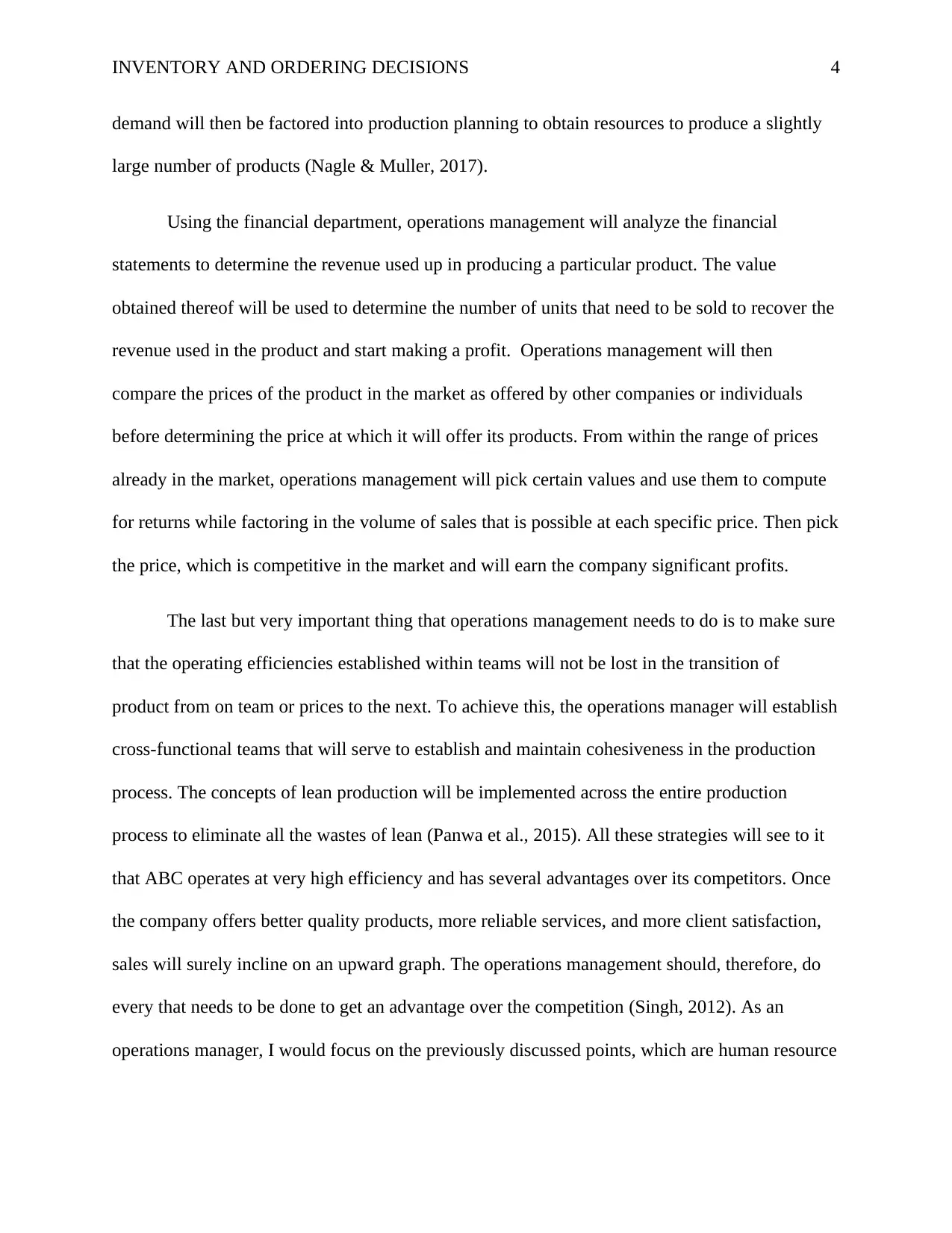
INVENTORY AND ORDERING DECISIONS 4
demand will then be factored into production planning to obtain resources to produce a slightly
large number of products (Nagle & Muller, 2017).
Using the financial department, operations management will analyze the financial
statements to determine the revenue used up in producing a particular product. The value
obtained thereof will be used to determine the number of units that need to be sold to recover the
revenue used in the product and start making a profit. Operations management will then
compare the prices of the product in the market as offered by other companies or individuals
before determining the price at which it will offer its products. From within the range of prices
already in the market, operations management will pick certain values and use them to compute
for returns while factoring in the volume of sales that is possible at each specific price. Then pick
the price, which is competitive in the market and will earn the company significant profits.
The last but very important thing that operations management needs to do is to make sure
that the operating efficiencies established within teams will not be lost in the transition of
product from on team or prices to the next. To achieve this, the operations manager will establish
cross-functional teams that will serve to establish and maintain cohesiveness in the production
process. The concepts of lean production will be implemented across the entire production
process to eliminate all the wastes of lean (Panwa et al., 2015). All these strategies will see to it
that ABC operates at very high efficiency and has several advantages over its competitors. Once
the company offers better quality products, more reliable services, and more client satisfaction,
sales will surely incline on an upward graph. The operations management should, therefore, do
every that needs to be done to get an advantage over the competition (Singh, 2012). As an
operations manager, I would focus on the previously discussed points, which are human resource
demand will then be factored into production planning to obtain resources to produce a slightly
large number of products (Nagle & Muller, 2017).
Using the financial department, operations management will analyze the financial
statements to determine the revenue used up in producing a particular product. The value
obtained thereof will be used to determine the number of units that need to be sold to recover the
revenue used in the product and start making a profit. Operations management will then
compare the prices of the product in the market as offered by other companies or individuals
before determining the price at which it will offer its products. From within the range of prices
already in the market, operations management will pick certain values and use them to compute
for returns while factoring in the volume of sales that is possible at each specific price. Then pick
the price, which is competitive in the market and will earn the company significant profits.
The last but very important thing that operations management needs to do is to make sure
that the operating efficiencies established within teams will not be lost in the transition of
product from on team or prices to the next. To achieve this, the operations manager will establish
cross-functional teams that will serve to establish and maintain cohesiveness in the production
process. The concepts of lean production will be implemented across the entire production
process to eliminate all the wastes of lean (Panwa et al., 2015). All these strategies will see to it
that ABC operates at very high efficiency and has several advantages over its competitors. Once
the company offers better quality products, more reliable services, and more client satisfaction,
sales will surely incline on an upward graph. The operations management should, therefore, do
every that needs to be done to get an advantage over the competition (Singh, 2012). As an
operations manager, I would focus on the previously discussed points, which are human resource
Paraphrase This Document
Need a fresh take? Get an instant paraphrase of this document with our AI Paraphraser
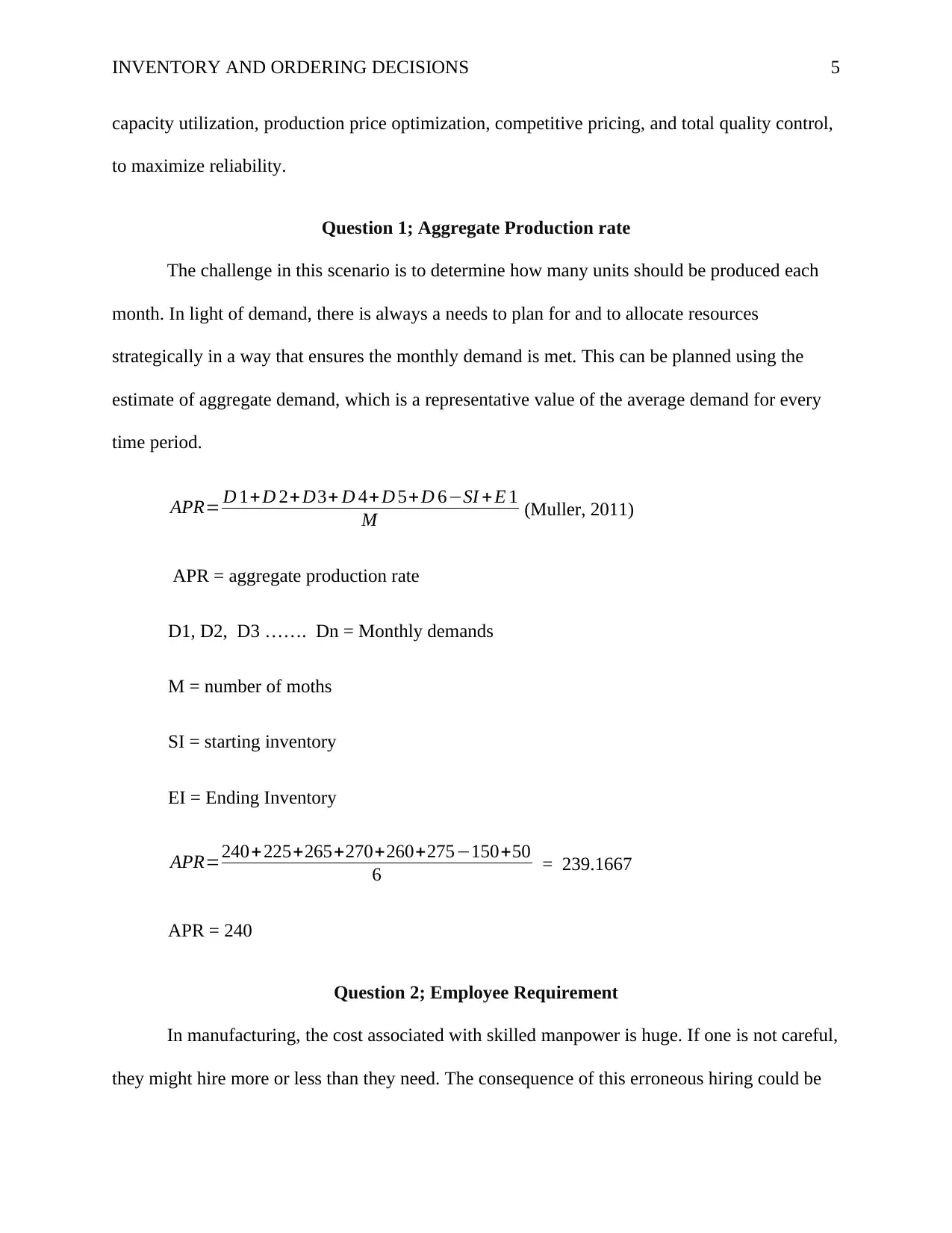
INVENTORY AND ORDERING DECISIONS 5
capacity utilization, production price optimization, competitive pricing, and total quality control,
to maximize reliability.
Question 1; Aggregate Production rate
The challenge in this scenario is to determine how many units should be produced each
month. In light of demand, there is always a needs to plan for and to allocate resources
strategically in a way that ensures the monthly demand is met. This can be planned using the
estimate of aggregate demand, which is a representative value of the average demand for every
time period.
APR= D 1+D 2+ D3+ D 4+ D 5+ D 6−SI + E 1
M (Muller, 2011)
APR = aggregate production rate
D1, D2, D3 ……. Dn = Monthly demands
M = number of moths
SI = starting inventory
EI = Ending Inventory
APR=240+ 225+265+270+260+275−150+50
6 = 239.1667
APR = 240
Question 2; Employee Requirement
In manufacturing, the cost associated with skilled manpower is huge. If one is not careful,
they might hire more or less than they need. The consequence of this erroneous hiring could be
capacity utilization, production price optimization, competitive pricing, and total quality control,
to maximize reliability.
Question 1; Aggregate Production rate
The challenge in this scenario is to determine how many units should be produced each
month. In light of demand, there is always a needs to plan for and to allocate resources
strategically in a way that ensures the monthly demand is met. This can be planned using the
estimate of aggregate demand, which is a representative value of the average demand for every
time period.
APR= D 1+D 2+ D3+ D 4+ D 5+ D 6−SI + E 1
M (Muller, 2011)
APR = aggregate production rate
D1, D2, D3 ……. Dn = Monthly demands
M = number of moths
SI = starting inventory
EI = Ending Inventory
APR=240+ 225+265+270+260+275−150+50
6 = 239.1667
APR = 240
Question 2; Employee Requirement
In manufacturing, the cost associated with skilled manpower is huge. If one is not careful,
they might hire more or less than they need. The consequence of this erroneous hiring could be
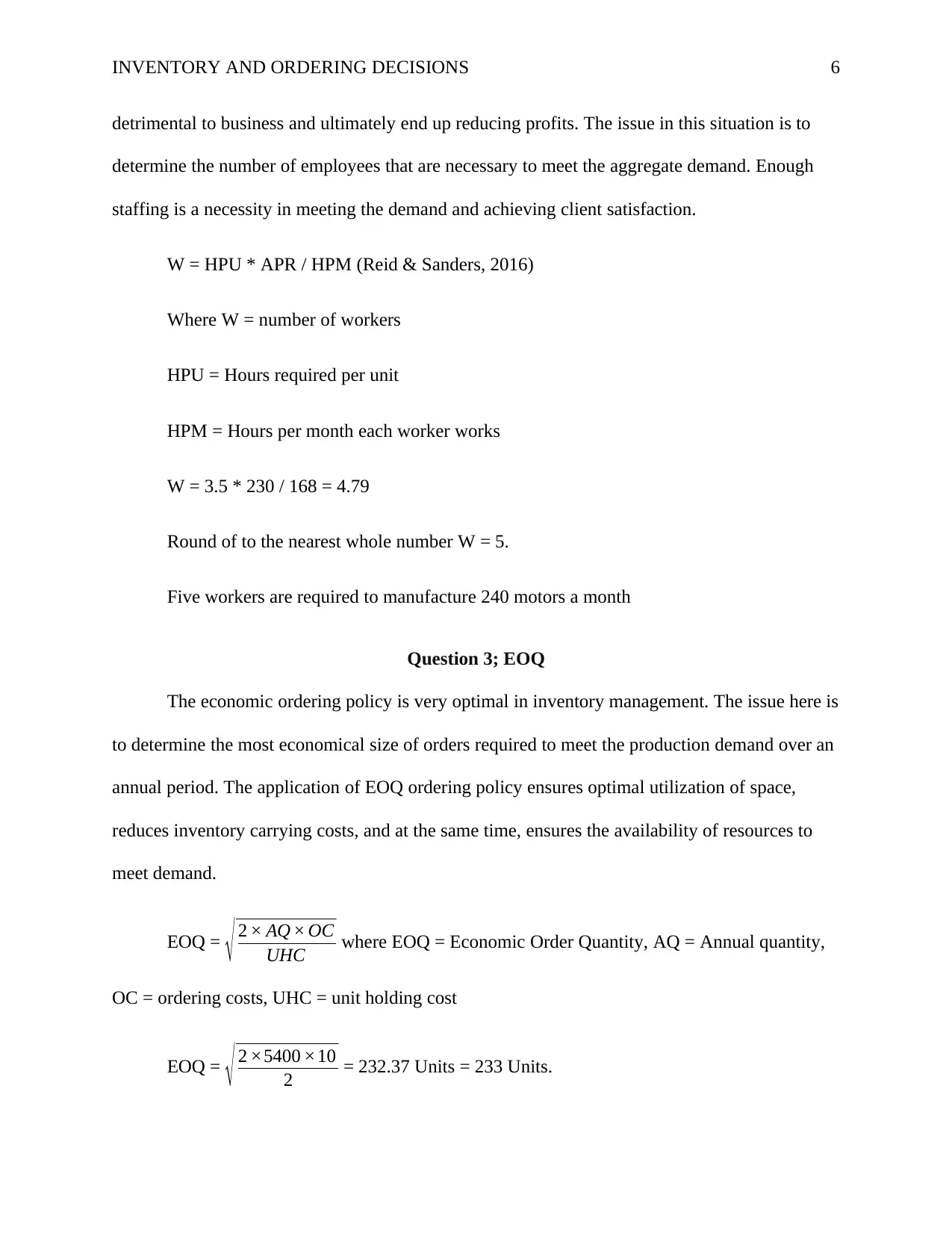
INVENTORY AND ORDERING DECISIONS 6
detrimental to business and ultimately end up reducing profits. The issue in this situation is to
determine the number of employees that are necessary to meet the aggregate demand. Enough
staffing is a necessity in meeting the demand and achieving client satisfaction.
W = HPU * APR / HPM (Reid & Sanders, 2016)
Where W = number of workers
HPU = Hours required per unit
HPM = Hours per month each worker works
W = 3.5 * 230 / 168 = 4.79
Round of to the nearest whole number W = 5.
Five workers are required to manufacture 240 motors a month
Question 3; EOQ
The economic ordering policy is very optimal in inventory management. The issue here is
to determine the most economical size of orders required to meet the production demand over an
annual period. The application of EOQ ordering policy ensures optimal utilization of space,
reduces inventory carrying costs, and at the same time, ensures the availability of resources to
meet demand.
EOQ = √ 2 × AQ × OC
UHC where EOQ = Economic Order Quantity, AQ = Annual quantity,
OC = ordering costs, UHC = unit holding cost
EOQ = √ 2 ×5400 ×10
2 = 232.37 Units = 233 Units.
detrimental to business and ultimately end up reducing profits. The issue in this situation is to
determine the number of employees that are necessary to meet the aggregate demand. Enough
staffing is a necessity in meeting the demand and achieving client satisfaction.
W = HPU * APR / HPM (Reid & Sanders, 2016)
Where W = number of workers
HPU = Hours required per unit
HPM = Hours per month each worker works
W = 3.5 * 230 / 168 = 4.79
Round of to the nearest whole number W = 5.
Five workers are required to manufacture 240 motors a month
Question 3; EOQ
The economic ordering policy is very optimal in inventory management. The issue here is
to determine the most economical size of orders required to meet the production demand over an
annual period. The application of EOQ ordering policy ensures optimal utilization of space,
reduces inventory carrying costs, and at the same time, ensures the availability of resources to
meet demand.
EOQ = √ 2 × AQ × OC
UHC where EOQ = Economic Order Quantity, AQ = Annual quantity,
OC = ordering costs, UHC = unit holding cost
EOQ = √ 2 ×5400 ×10
2 = 232.37 Units = 233 Units.
⊘ This is a preview!⊘
Do you want full access?
Subscribe today to unlock all pages.

Trusted by 1+ million students worldwide
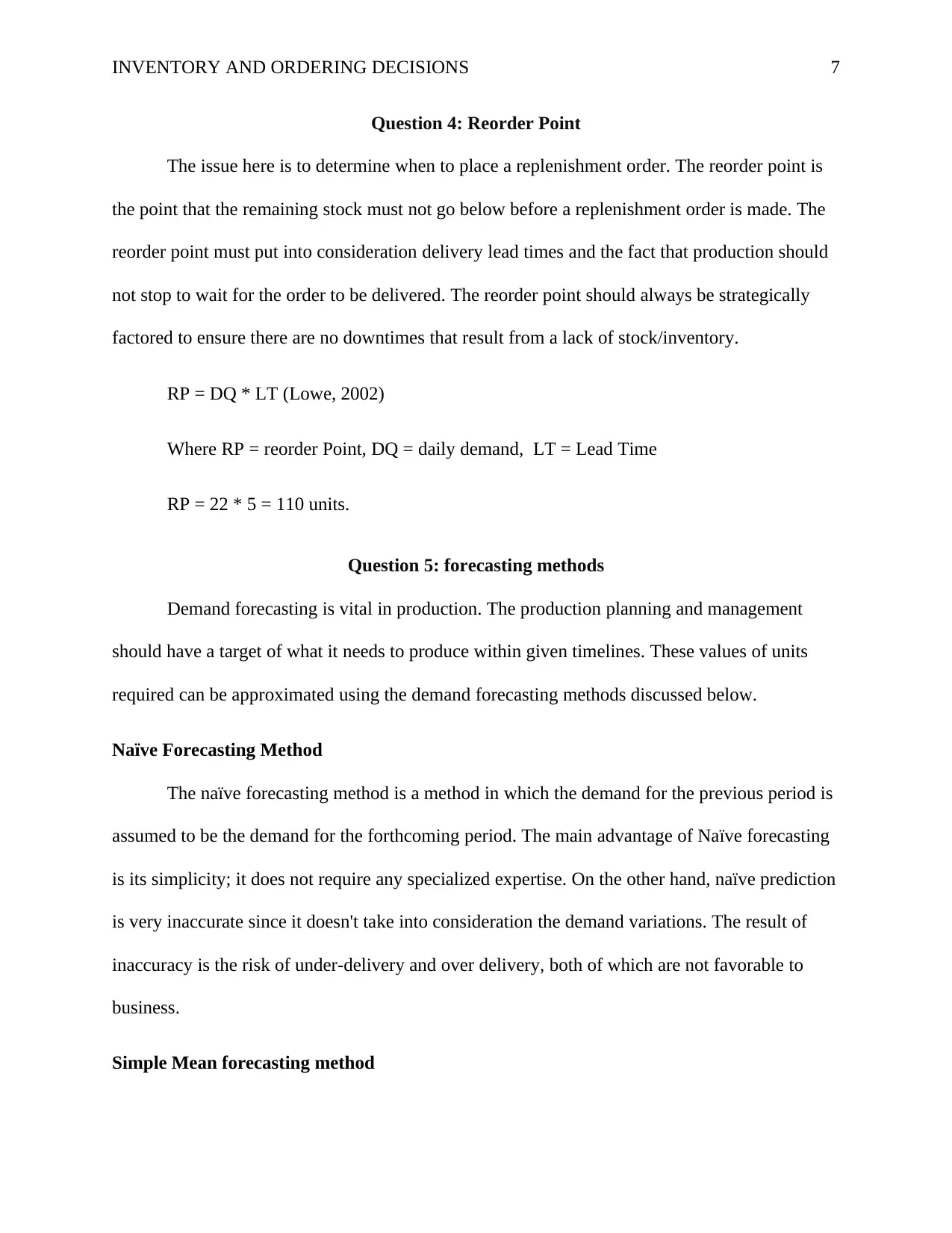
INVENTORY AND ORDERING DECISIONS 7
Question 4: Reorder Point
The issue here is to determine when to place a replenishment order. The reorder point is
the point that the remaining stock must not go below before a replenishment order is made. The
reorder point must put into consideration delivery lead times and the fact that production should
not stop to wait for the order to be delivered. The reorder point should always be strategically
factored to ensure there are no downtimes that result from a lack of stock/inventory.
RP = DQ * LT (Lowe, 2002)
Where RP = reorder Point, DQ = daily demand, LT = Lead Time
RP = 22 * 5 = 110 units.
Question 5: forecasting methods
Demand forecasting is vital in production. The production planning and management
should have a target of what it needs to produce within given timelines. These values of units
required can be approximated using the demand forecasting methods discussed below.
Naïve Forecasting Method
The naïve forecasting method is a method in which the demand for the previous period is
assumed to be the demand for the forthcoming period. The main advantage of Naïve forecasting
is its simplicity; it does not require any specialized expertise. On the other hand, naïve prediction
is very inaccurate since it doesn't take into consideration the demand variations. The result of
inaccuracy is the risk of under-delivery and over delivery, both of which are not favorable to
business.
Simple Mean forecasting method
Question 4: Reorder Point
The issue here is to determine when to place a replenishment order. The reorder point is
the point that the remaining stock must not go below before a replenishment order is made. The
reorder point must put into consideration delivery lead times and the fact that production should
not stop to wait for the order to be delivered. The reorder point should always be strategically
factored to ensure there are no downtimes that result from a lack of stock/inventory.
RP = DQ * LT (Lowe, 2002)
Where RP = reorder Point, DQ = daily demand, LT = Lead Time
RP = 22 * 5 = 110 units.
Question 5: forecasting methods
Demand forecasting is vital in production. The production planning and management
should have a target of what it needs to produce within given timelines. These values of units
required can be approximated using the demand forecasting methods discussed below.
Naïve Forecasting Method
The naïve forecasting method is a method in which the demand for the previous period is
assumed to be the demand for the forthcoming period. The main advantage of Naïve forecasting
is its simplicity; it does not require any specialized expertise. On the other hand, naïve prediction
is very inaccurate since it doesn't take into consideration the demand variations. The result of
inaccuracy is the risk of under-delivery and over delivery, both of which are not favorable to
business.
Simple Mean forecasting method
Paraphrase This Document
Need a fresh take? Get an instant paraphrase of this document with our AI Paraphraser
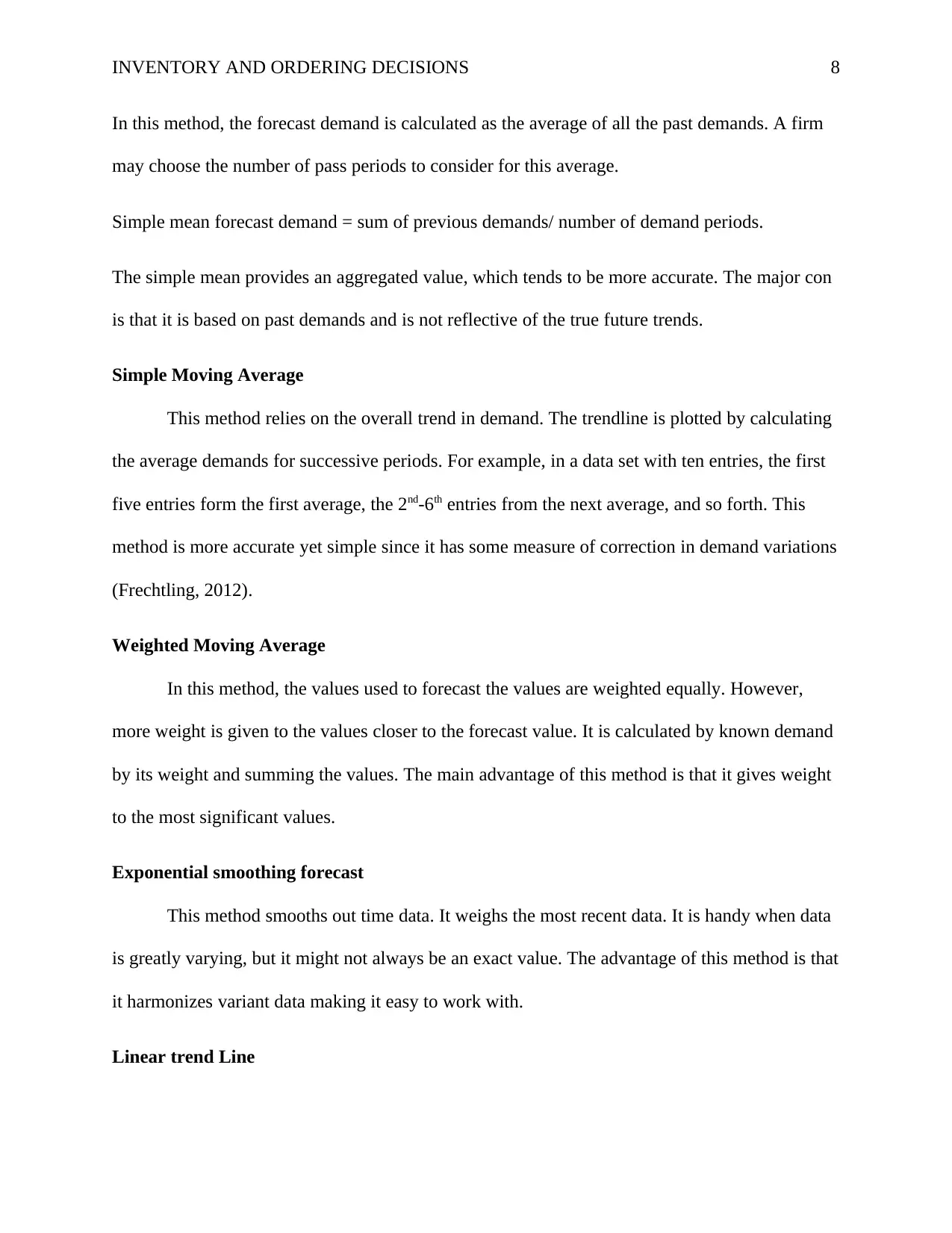
INVENTORY AND ORDERING DECISIONS 8
In this method, the forecast demand is calculated as the average of all the past demands. A firm
may choose the number of pass periods to consider for this average.
Simple mean forecast demand = sum of previous demands/ number of demand periods.
The simple mean provides an aggregated value, which tends to be more accurate. The major con
is that it is based on past demands and is not reflective of the true future trends.
Simple Moving Average
This method relies on the overall trend in demand. The trendline is plotted by calculating
the average demands for successive periods. For example, in a data set with ten entries, the first
five entries form the first average, the 2nd-6th entries from the next average, and so forth. This
method is more accurate yet simple since it has some measure of correction in demand variations
(Frechtling, 2012).
Weighted Moving Average
In this method, the values used to forecast the values are weighted equally. However,
more weight is given to the values closer to the forecast value. It is calculated by known demand
by its weight and summing the values. The main advantage of this method is that it gives weight
to the most significant values.
Exponential smoothing forecast
This method smooths out time data. It weighs the most recent data. It is handy when data
is greatly varying, but it might not always be an exact value. The advantage of this method is that
it harmonizes variant data making it easy to work with.
Linear trend Line
In this method, the forecast demand is calculated as the average of all the past demands. A firm
may choose the number of pass periods to consider for this average.
Simple mean forecast demand = sum of previous demands/ number of demand periods.
The simple mean provides an aggregated value, which tends to be more accurate. The major con
is that it is based on past demands and is not reflective of the true future trends.
Simple Moving Average
This method relies on the overall trend in demand. The trendline is plotted by calculating
the average demands for successive periods. For example, in a data set with ten entries, the first
five entries form the first average, the 2nd-6th entries from the next average, and so forth. This
method is more accurate yet simple since it has some measure of correction in demand variations
(Frechtling, 2012).
Weighted Moving Average
In this method, the values used to forecast the values are weighted equally. However,
more weight is given to the values closer to the forecast value. It is calculated by known demand
by its weight and summing the values. The main advantage of this method is that it gives weight
to the most significant values.
Exponential smoothing forecast
This method smooths out time data. It weighs the most recent data. It is handy when data
is greatly varying, but it might not always be an exact value. The advantage of this method is that
it harmonizes variant data making it easy to work with.
Linear trend Line
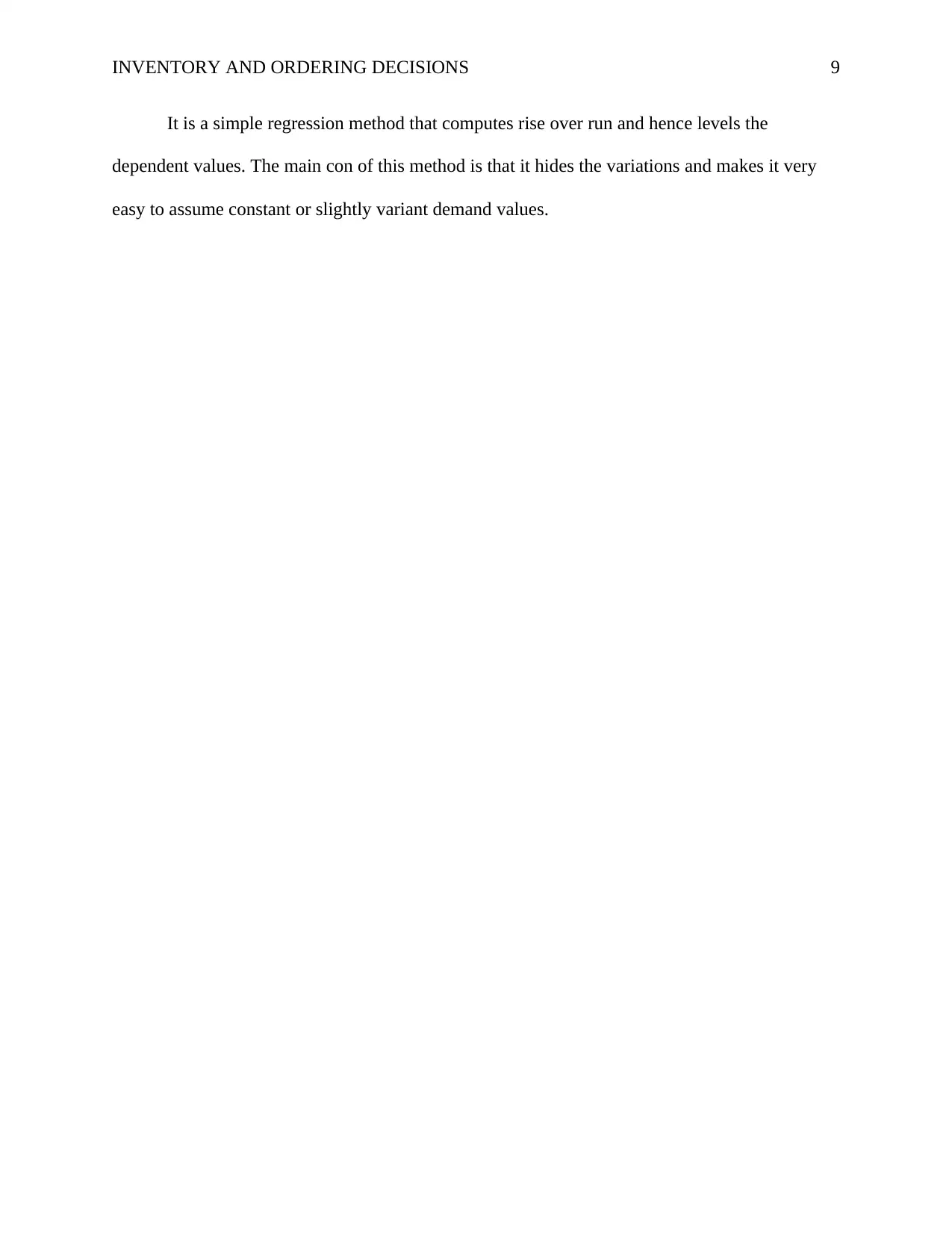
INVENTORY AND ORDERING DECISIONS 9
It is a simple regression method that computes rise over run and hence levels the
dependent values. The main con of this method is that it hides the variations and makes it very
easy to assume constant or slightly variant demand values.
It is a simple regression method that computes rise over run and hence levels the
dependent values. The main con of this method is that it hides the variations and makes it very
easy to assume constant or slightly variant demand values.
⊘ This is a preview!⊘
Do you want full access?
Subscribe today to unlock all pages.

Trusted by 1+ million students worldwide
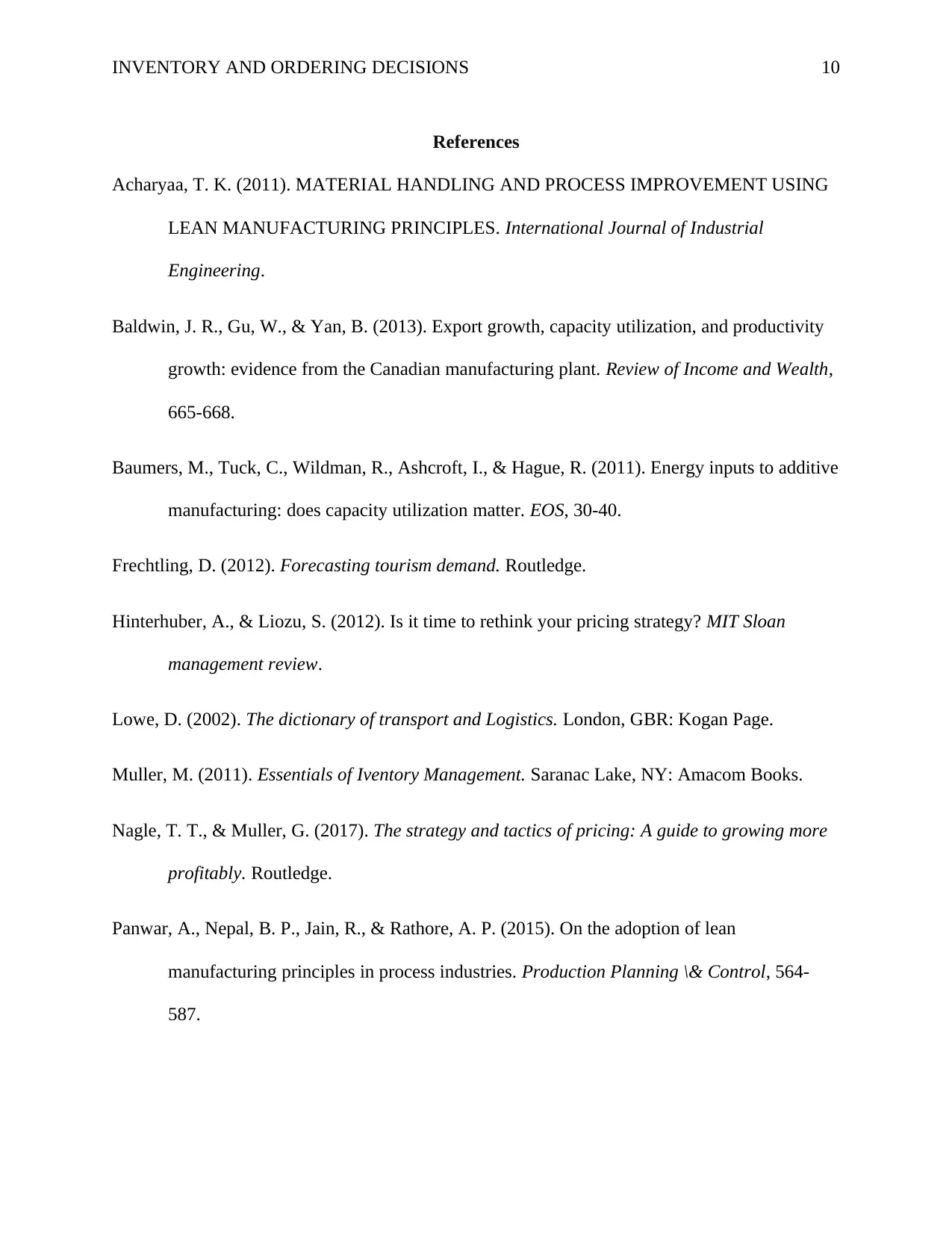
INVENTORY AND ORDERING DECISIONS 10
References
Acharyaa, T. K. (2011). MATERIAL HANDLING AND PROCESS IMPROVEMENT USING
LEAN MANUFACTURING PRINCIPLES. International Journal of Industrial
Engineering.
Baldwin, J. R., Gu, W., & Yan, B. (2013). Export growth, capacity utilization, and productivity
growth: evidence from the Canadian manufacturing plant. Review of Income and Wealth,
665-668.
Baumers, M., Tuck, C., Wildman, R., Ashcroft, I., & Hague, R. (2011). Energy inputs to additive
manufacturing: does capacity utilization matter. EOS, 30-40.
Frechtling, D. (2012). Forecasting tourism demand. Routledge.
Hinterhuber, A., & Liozu, S. (2012). Is it time to rethink your pricing strategy? MIT Sloan
management review.
Lowe, D. (2002). The dictionary of transport and Logistics. London, GBR: Kogan Page.
Muller, M. (2011). Essentials of Iventory Management. Saranac Lake, NY: Amacom Books.
Nagle, T. T., & Muller, G. (2017). The strategy and tactics of pricing: A guide to growing more
profitably. Routledge.
Panwar, A., Nepal, B. P., Jain, R., & Rathore, A. P. (2015). On the adoption of lean
manufacturing principles in process industries. Production Planning \& Control, 564-
587.
References
Acharyaa, T. K. (2011). MATERIAL HANDLING AND PROCESS IMPROVEMENT USING
LEAN MANUFACTURING PRINCIPLES. International Journal of Industrial
Engineering.
Baldwin, J. R., Gu, W., & Yan, B. (2013). Export growth, capacity utilization, and productivity
growth: evidence from the Canadian manufacturing plant. Review of Income and Wealth,
665-668.
Baumers, M., Tuck, C., Wildman, R., Ashcroft, I., & Hague, R. (2011). Energy inputs to additive
manufacturing: does capacity utilization matter. EOS, 30-40.
Frechtling, D. (2012). Forecasting tourism demand. Routledge.
Hinterhuber, A., & Liozu, S. (2012). Is it time to rethink your pricing strategy? MIT Sloan
management review.
Lowe, D. (2002). The dictionary of transport and Logistics. London, GBR: Kogan Page.
Muller, M. (2011). Essentials of Iventory Management. Saranac Lake, NY: Amacom Books.
Nagle, T. T., & Muller, G. (2017). The strategy and tactics of pricing: A guide to growing more
profitably. Routledge.
Panwar, A., Nepal, B. P., Jain, R., & Rathore, A. P. (2015). On the adoption of lean
manufacturing principles in process industries. Production Planning \& Control, 564-
587.
Paraphrase This Document
Need a fresh take? Get an instant paraphrase of this document with our AI Paraphraser
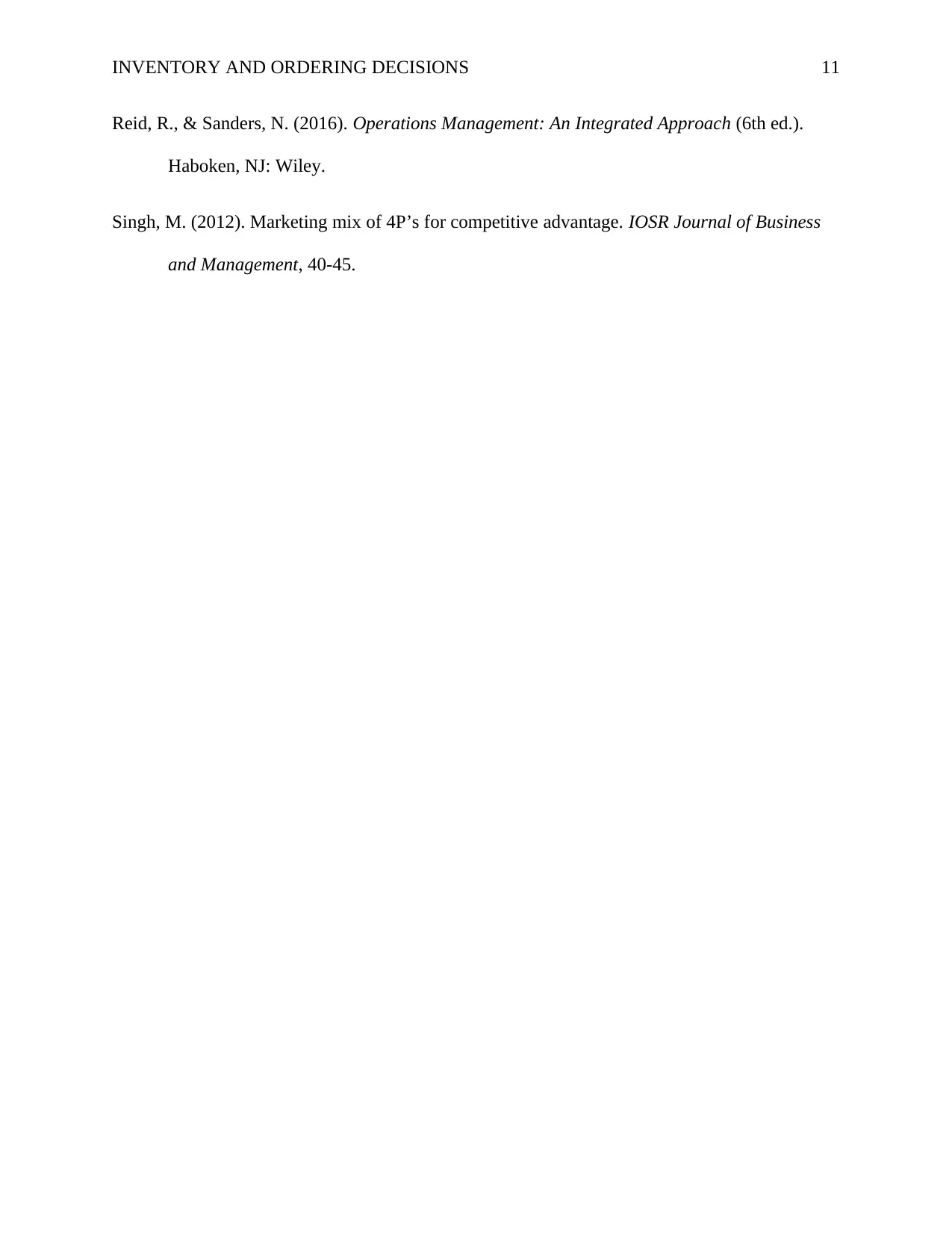
INVENTORY AND ORDERING DECISIONS 11
Reid, R., & Sanders, N. (2016). Operations Management: An Integrated Approach (6th ed.).
Haboken, NJ: Wiley.
Singh, M. (2012). Marketing mix of 4P’s for competitive advantage. IOSR Journal of Business
and Management, 40-45.
Reid, R., & Sanders, N. (2016). Operations Management: An Integrated Approach (6th ed.).
Haboken, NJ: Wiley.
Singh, M. (2012). Marketing mix of 4P’s for competitive advantage. IOSR Journal of Business
and Management, 40-45.
1 out of 11
Related Documents
Your All-in-One AI-Powered Toolkit for Academic Success.
+13062052269
info@desklib.com
Available 24*7 on WhatsApp / Email
![[object Object]](/_next/static/media/star-bottom.7253800d.svg)
Unlock your academic potential
Copyright © 2020–2025 A2Z Services. All Rights Reserved. Developed and managed by ZUCOL.





